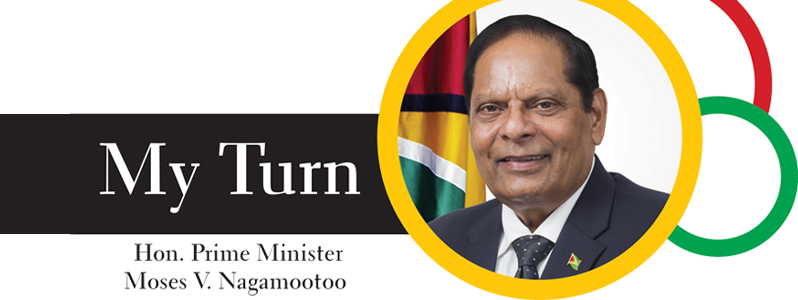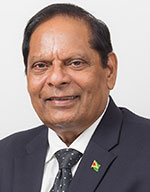KAIMEN! Halekuba! Miari Mang! Pararubo! Bowkaya! Waku Pena! and Kirwane! These are different salutations in some of our Guyanese indigenous languages, which mean “Hi” and “Hello.”
Yesterday, I had fun in Aishalton in Upper Takutu-Upper Essequibo learning to pronounce melodious words from the languages of the Wapichan, Lokono/Arawak, Machushi, Warrau, Carib, Patamona, Wai Wai and Akawaio first nations of Guyana.
The occasion was the Launch of the Guyana observance of 2019 as the United Nations’ Year of Indigenous Languages. It was also the inauguration of local programming at Radio Aishalton.
Among those attending the historic events were Vice-President and Minister of Indigenous Peoples’ Affairs Minister, Sydney Allicock; Minister Valerie Garrido-Lowe; University of Guyana Vice-Chancellor Dr. Ivelaw Griffith; Toshaos from nine Amerindian villages, and high-level representatives from the Ministry of Education and UNESCO.
WAPICHAN WELCOME
Upon our arrival, we were given a “Wapichan Welcome.” We were greeted by Michael Thomas, the youngest-ever Toshao of Aishalton, and other village leaders. Children waved Guyana flags and sang the National Anthem in Wapichan. Various representatives welcomed the large gathering with greetings in the nine Indigenous languages (10, if you include Creolese). We were entertained with a cultural fiesta under the freshly thatched roof of an open tent.
Yesterday was indeed a very special day in Aishalton, and indeed all around Guyana for two reasons:-
Firstly, this entire programme was carried LIVE on Radio Aishalton and from that station to the Voice of Guyana (VOG) at NCN Headquarters in Georgetown, then to all around Guyana, and in many parts of the world. It is the very first time that this has happened in Aishalton, a remote, hinterland village of Indigenous peoples.
REGIONAL RADIO STATIONS
Over the past two years, the Office of the Prime Minister commissioned radio stations in Lethem, Mabaruma, Bartica, Madhia, Orealla and Aishalton. In all these locations, in the past two years, we have established some of the most modern radio stations in the Caribbean. We trained a corps of local broadcasters, some fluent in Indigenous languages, to go on air at these regional radio stations. Our APNU+AFC coalition government wanted our hinterland or interior regions to know what’s happening in Georgetown and on the rest of the coast. It is our President, His Excellency David Granger, who insisted that we must integrate the hinterland with the coast. We are 10 regions, but we are One Guyana!
Yesterday, I recounted my first encounter with the Rupununi during 1969, when I had started a news bulletin titled “Interior Special”, to highlight conditions in Amerindian villages. And when I became Minister of Information in 1992, I immediately directed the production of a monthly magazine, “Hinterland Highlights.” This magazine has been resuscitated under the coalition government, and remains a colourful and popular monthly publication.
The idea has been, and still remains, that our Indigenous peoples have a right to know. This is the goal of our government. An informed population is an educated population. We insist that our Indigenous peoples must NOT be left out, or left behind in the information, education and technological revolution! This is why, for the first time, several hinterland communities have internet access, and now radio broadcast services. Ahead, we plan to provide satellite transmission of television programmes, other than those on the Learning Channel, to every part of Guyana.
This has been an exciting journey, starting with fixing the studio at Radio Paiwomak, and encouraging local programmes in the Machushi language for audiences in Annai and Iwokrama, and surrounding areas.
FOOD FOR THE MIND
Besides Radio Paiwomak, the regional radio stations have been a huge hit among hinterland communities and, quite deservedly so, the coalition gets credit for its vision and innovation.
But during recent debates in the National Assembly, the opposition leader mocked these facilities, saying “the people can’t eat radio stations.” That was sheer wickedness, but when his PPP backbenchers chorused “so true; so true”, I recited in my mind a verse from the Bible: “Father forgive them for they know not what they do” Or, say!
Our radio stations provide food for the minds, for the intellects of our hinterland residents. They nourish them with information, education and entertainment, and feed their appetites for relaxation and leisure with diverse cultural programmes. Our radio stations bring to indigenous communities healthy music and songs, and other cultural treats in indigenous languages. It was the English writer William Shakespeare, who said, “if music be the food of love, play on!” Our regional stations will play on!
CREOLESE LANGUAGE
It is true but sad that not many people outside Indigenous communities know any thing about the languages that our native peoples speak. Besides English, we accept as a Guyanese language creolese or patois.
People know us by the way we speak. A Guyanese stands out anywhere when you hear the words, “what happen deh?” Once I was travelling in a train in Toronto and as the train stopped, I heard a female voice from a distance saying, “walk good, gal!” I didn’t see the person who said that, but I knew it had to be a Guyanese! And, we also get that feeling that it’s a Guyanese thing, when we hear songs from Dave Martins.
So, I hope that soon when we hear the words “kaimen” and “halekuba”, we would know that it’s our Guyanese Indigenous peoples speaking!
Yesterday, I told the Aishalton gathering that we must count our languages among our blessings. Our languages hold extraordinary value for our unique civilisation and our heritage. I say to our indigenous peoples: hold on to what you have. Preserve it. Promote it. Your government will help you to do so.
For those who say that your languages are dead, share this story with them. When I first started to learn Latin in 1963, my teacher told the class a story of how someone had said that Latin was a “dead language.” His reply was: “Yes, I know. But my mother is dead also, but I still love her.”
GREATEST WEALTH
Guyana is blessed with an abundance of physical beauty and material wealth in our forests, savannahs, rivers, open plains, mountains and waterfalls; even under the Guyanese earth, on land and in the sea. Like our oil and gas resources, all these will be explored for the benefit of all Guyanese now, and in years to come.
But our greatest beauty and wealth, by far, reside in the people of Guyana through our heritage, history and cultural diversity, which make us uniquely Guyanese. Our Indigenous peoples of Guyana are a truly precious and important aspect of this wonderful fabric called “Guyanese.” And our Indigenous languages are slowly being recognised as a unique cultural resource that we need to both explore and promote.
January 20, 2019












